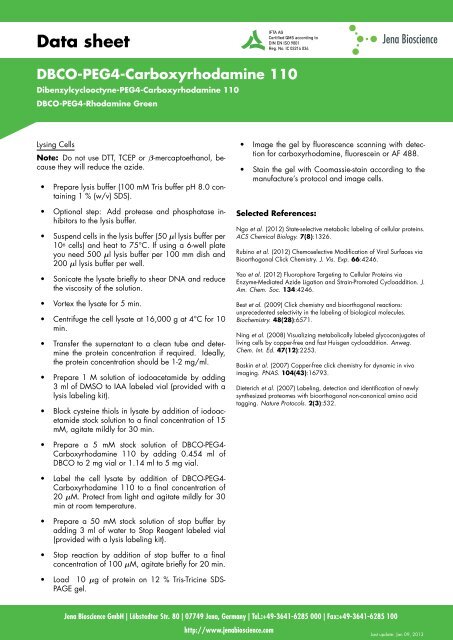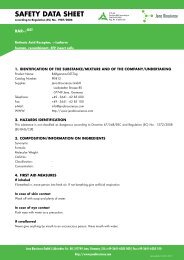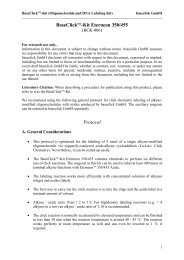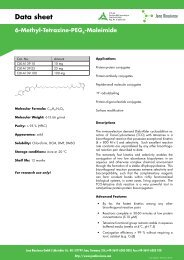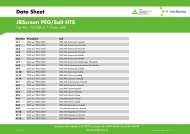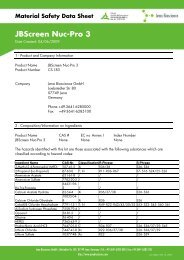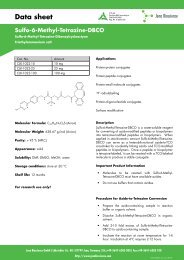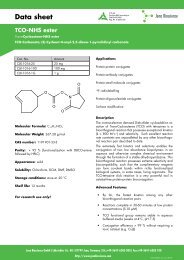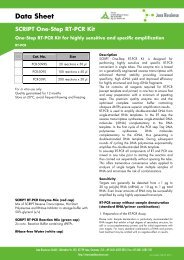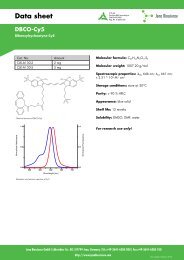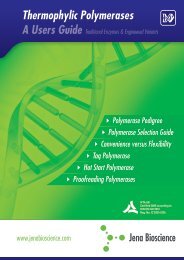Data sheet DBCO-PEG4-Carboxyrhodamine 110 - Jena Bioscience
Data sheet DBCO-PEG4-Carboxyrhodamine 110 - Jena Bioscience
Data sheet DBCO-PEG4-Carboxyrhodamine 110 - Jena Bioscience
Create successful ePaper yourself
Turn your PDF publications into a flip-book with our unique Google optimized e-Paper software.
<strong>Data</strong> <strong>sheet</strong><br />
<strong>DBCO</strong>-<strong>PEG4</strong>-<strong>Carboxyrhodamine</strong> <strong>110</strong><br />
Dibenzylcyclooctyne-<strong>PEG4</strong>-<strong>Carboxyrhodamine</strong> <strong>110</strong><br />
<strong>DBCO</strong>-<strong>PEG4</strong>-Rhodamine Green<br />
Lysing Cells<br />
Note: Do not use DTT, TCEP or β-mercaptoethanol, because<br />
they will reduce the azide.<br />
• Prepare lysis buffer (100 mM Tris buffer pH 8.0 containing<br />
1 % (w/v) SDS).<br />
• Optional step: Add protease and phosphatase inhibitors<br />
to the lysis buffer.<br />
• Suspend cells in the lysis buffer (50 µl lysis buffer per<br />
10 6 cells) and heat to 75°C. If using a 6-well plate<br />
you need 500 µl lysis buffer per 100 mm dish and<br />
200 µl lysis buffer per well.<br />
• Sonicate the lysate briefly to shear DNA and reduce<br />
the viscosity of the solution.<br />
• Vortex the lysate for 5 min.<br />
• Centrifuge the cell lysate at 16,000 g at 4°C for 10<br />
min.<br />
• Transfer the supernatant to a clean tube and determine<br />
the protein concentration if required. Ideally,<br />
the protein concentration should be 1-2 mg/ml.<br />
• Prepare 1 M solution of iodoacetamide by adding<br />
3 ml of DMSO to IAA labeled vial (provided with a<br />
lysis labeling kit).<br />
• Block cysteine thiols in lysate by addition of iodoacetamide<br />
stock solution to a final concentration of 15<br />
mM, agitate mildly for 30 min.<br />
• Prepare a 5 mM stock solution of <strong>DBCO</strong>-<strong>PEG4</strong>-<br />
<strong>Carboxyrhodamine</strong> <strong>110</strong> by adding 0.454 ml of<br />
<strong>DBCO</strong> to 2 mg vial or 1.14 ml to 5 mg vial.<br />
• Label the cell lysate by addition of <strong>DBCO</strong>-<strong>PEG4</strong>-<br />
<strong>Carboxyrhodamine</strong> <strong>110</strong> to a final concentration of<br />
20 µM. Protect from light and agitate mildly for 30<br />
min at room temperature.<br />
• Prepare a 50 mM stock solution of stop buffer by<br />
adding 3 ml of water to Stop Reagent labeled vial<br />
(provided with a lysis labeling kit).<br />
• Stop reaction by addition of stop buffer to a final<br />
concentration of 100 µM, agitate briefly for 20 min.<br />
• Load 10 µg of protein on 12 % Tris-Tricine SDS-<br />
PAGE gel.<br />
• Image the gel by fluorescence scanning with detection<br />
for carboxyrhodamine, fluorescein or AF 488.<br />
• Stain the gel with Coomassie-stain according to the<br />
manufacture’s protocol and image cells.<br />
Selected References:<br />
Ngo et al. (2012) State-selective metabolic labeling of cellular proteins.<br />
ACS Chemical Biology. 7(8):1326.<br />
Rubino et al. (2012) Chemoselective Modification of Viral Surfaces via<br />
Bioorthogonal Click Chemistry. J. Vis. Exp. 66:4246.<br />
Yao et al. (2012) Fluorophore Targeting to Cellular Proteins via<br />
Enzyme-Mediated Azide Ligation and Strain-Promoted Cycloaddition. J.<br />
Am. Chem. Soc. 134:4246.<br />
Best et al. (2009) Click chemistry and bioorthogonal reactions:<br />
unprecedented selectivity in the labeling of biological molecules.<br />
Biochemistry. 48(28):6571.<br />
Ning et al. (2008) Visualizing metabolically labeled glycoconjugates of<br />
living cells by copper-free and fast Huisgen cycloaddition. Anweg.<br />
Chem. Int. Ed. 47(12):2253.<br />
Baskin et al. (2007) Copper-free click chemistry for dynamic in vivo<br />
imaging. PNAS. 104(43):16793.<br />
Dieterich et al. (2007) Labeling, detection and identification of newly<br />
synthesized proteomes with bioorthogonal non-canonical amino acid<br />
tagging. Nature Protocols. 2(3):532.<br />
<strong>Jena</strong> <strong>Bioscience</strong> GmbH | Löbstedter Str. 80 | 07749 <strong>Jena</strong>, Germany | Tel.:+49-3641-6285 000 | Fax:+49-3641-6285 100<br />
http://www.jenabioscience.com<br />
Last update: Jan 09, 2013


